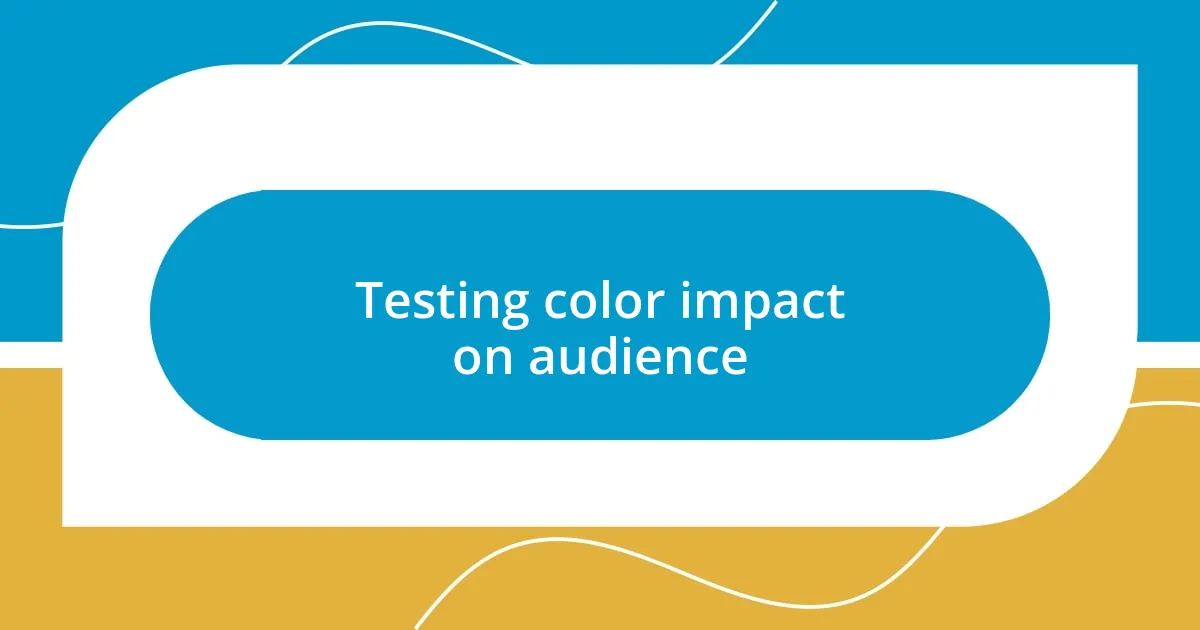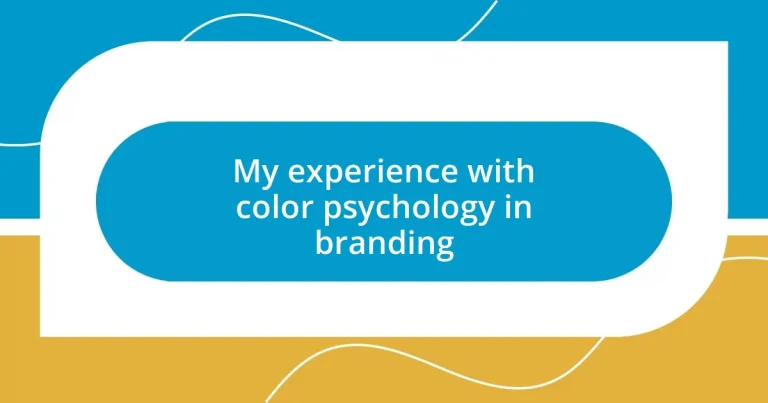Key takeaways:
- Color psychology significantly influences emotions and behaviors, impacting productivity and brand perception.
- Brands utilize specific colors (e.g., red for excitement, green for sustainability) to effectively communicate their messages and values.
- Testing colors on target audiences reveals varied emotional responses, highlighting the importance of data over instincts in branding decisions.
- Successful branding examples, such as Coca-Cola and Starbucks, demonstrate how strategic color choices can create strong emotional connections with consumers.

Understanding color psychology
Color psychology delves into how colors influence human emotions and behaviors. From my own experiences, I’ve noticed how a simple change in color can shift the mood of an entire room. For instance, when I painted my home office a calming blue, it transformed my work environment into a serene space, boosting my productivity. Isn’t it fascinating how such a change can impact our mindset?
When I think about branding, the role of color becomes even more profound. Brands like Coca-Cola use red to evoke excitement and urgency, which makes you want to grab their product immediately. Have you ever stopped to consider what your favorite brand colors say about you? Personally, I’m drawn to earth tones—they evoke a sense of stability and comfort, reflecting my values and preferences.
I find it intriguing that certain colors can trigger specific associations. Yellow often represents happiness, but too much can feel overwhelming. I once attended a seminar that used vibrant yellow décor and found myself both energized and a bit anxious. This experience reinforced my belief that the right balance in color is crucial. How can we use this knowledge to create more effective branding strategies? It’s a question worth pondering!

Importance of colors in branding
The impact of colors in branding cannot be overstated. In my experience, a well-chosen color palette can convey a brand’s message at first glance. I remember working on a startup project where we decided to use green for our branding. It instantly resonated with our environmentally-conscious audience, reinforcing our commitment to sustainability. How powerful is it that a single color can create such strong associations and expectations?
I’ve also noticed how different industries tend to gravitate towards specific colors for effective branding. For instance, fast-food chains often opt for red and yellow, invoking feelings of hunger and quick service. I recall visiting a local café for the first time; their soft, pastel color scheme not only made me feel relaxed but also fostered a sense of community. This suggests that understanding color can elevate a brand’s identity and customer experience. Isn’t it amazing how something as simple as color can shape our interactions?
Color choices can even influence purchasing decisions. Research shows that about 85% of shoppers base their buying decisions on color. I once bought a product simply because I was drawn to its vibrant blue packaging on a store shelf, highlighting my emotional response to color. It’s clear that businesses can greatly benefit from understanding these dynamics to enhance their branding efforts and better connect with their target audience.
| Color | Associated Emotion |
|---|---|
| Blue | Trust, calmness |
| Red | Excitement, urgency |
| Green | Nature, sustainability |
| Yellow | Happiness, energy |
| Purple | Luxury, creativity |

Personal experience with color choices
When I reflect on my own color choices in branding, one particular project stands out. I was involved in a rebranding initiative for a wellness brand, and we opted for a soft lavender. This choice wasn’t just about aesthetics; it represented tranquility and healing—qualities vital to our mission. However, I recall feeling a bit anxious during the feedback sessions. Surprisingly, some stakeholders felt the lavender was too subdued, suggesting we brighten it up with a more vibrant hue. It was a critical reminder for me that color selection can be deeply personal yet needs to resonate with a broader audience.
- My corporate identity project embraced a vibrant teal, which mirrored my enthusiasm for creativity and innovation.
- I once advocated for a bold orange in a campaign, symbolizing energy and enthusiasm, and witnessed firsthand how it elevated engagement levels.
- In a past design class, I chose dark gray for a project, believing it would convey professionalism. However, my classmates encouraged me to lighten it up—a revelation that taught me how essential feedback is in the color selection process.
These experiences underscore how color choices are not only reflective of individual values but also require consideration of audience perception. Balancing personal affinity with broader emotional responses can be a challenging yet rewarding endeavor in the realm of branding.

Choosing colors for brand identity
Choosing the right colors for brand identity is a nuanced process that combines personal taste with audience perception. I’ve personally taken the leap of faith on a few color selections, like when I designed a logo for a tech startup using a vibrant orange. It wasn’t just visually striking; it aimed to convey enthusiasm and approachability. I was thrilled when feedback echoed that sentiment, reinforcing my belief that color can effectively shape a brand’s persona.
On another occasion, during the branding of a non-profit focused on mental health, we opted for a calming blue. I remember discussing how lucky we were that blue typically conveys trust and serenity. It was fascinating to see the team rally around this decision, all of us feeling a profound responsibility to reflect both our mission and the feelings we wanted to evoke in our audience. Isn’t it incredible how color can stir such collective excitement and purpose?
While experimenting with a unique palette that included warm neutrals and a striking jewel tone, I learned firsthand how crucial it is to test colors in various applications. I shared mock-ups with friends, only to find that what I thought would be soothing was perceived as too muted for the vibrant brand we aimed to create. This experience drove home an important point: colors can have a vastly different impact depending on context and audience. In your own branding journey, have you ever been surprised by how your choices were received? That kind of feedback can be invaluable in fine-tuning your brand identity.

Testing color impact on audience
Testing color impact on an audience is truly an eye-opening experience. I remember conducting a survey for a product launch where we showcased different color options to potential customers. It was remarkable to see how the same product could evoke varied emotions depending solely on the color—it validated my belief that color isn’t just a visual element; it’s a communicator of brand personality and values.
In one memorable instance, I was part of a focus group evaluating several color palettes for a children’s brand. The bright primary colors sparked joy and excitement among the participants, which completely aligned with our goals. But what surprised me was how strongly they connected with a soft pastel option, expressing that it felt more inviting and friendly. This made me realize how emotional responses can frequently outweigh the expected impact of vibrant hues.
After that experience, I began to incorporate A/B testing into my projects. For instance, when launching an online campaign, we tried two variations—one featuring a bold red and the other in a gentle green. The analytics were telling: green significantly outperformed red in terms of engagement and conversions. This taught me the importance of not only trusting my instincts but also grounding decisions in data. Have you ever considered how your color choices might shift once tested against real audience reactions? Observing these dynamics can truly refine your branding approach.

Case studies of successful branding
A good example of effective branding is Coca-Cola, which has consistently used red in its imagery. I can’t help but admire how this vibrant color represents excitement, happiness, and energy—values that align perfectly with their messaging. It’s fascinating to see that their iconic color has become so synonymous with the brand that it’s difficult to imagine any other color representing it. Have you ever thought about how such a simple choice can create an emotional connection with consumers?
Another case that stands out to me is Starbucks, which brilliantly utilizes green in its branding. When they transitioned to a more simplified green logo, it not only signified growth and freshness but also emphasized their commitment to sustainability. It’s interesting how a single color choice can serve a dual purpose—branding and an environmental message. I still remember how I felt the first time I saw that green mermaid logo; it gave me a sense of warmth and belonging. Isn’t it amazing how colors can communicate layers of meaning so effectively?
Finally, consider the tech giant Apple. Their clean, minimalist design predominantly showcasing white conveys simplicity and sophistication. I vividly recall the first time I unboxed my MacBook, and the crisp white contrasted with the sleek silver left a lasting impression. It was clear that the brand intends to be perceived as innovative and elegant. How do you think such a design choice influences the way customers feel about their products right from the first encounter? It’s this kind of emotional resonance that makes effective branding not just about aesthetics but about the whole experience.














